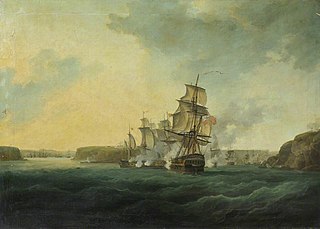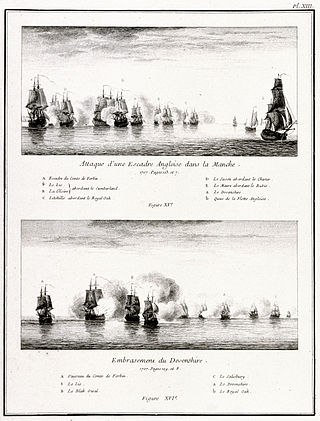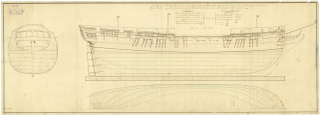HMS Ganges was a 74-gun third-rate ship of the line of the Royal Navy, launched in 1782 at Rotherhithe. She was the first ship of the Navy to bear the name, and was the name ship of her class. She saw active service from 1782 to 1811, in Europe and the West Indies.

HMS Cornwall was a 74-gun third-rate Vengeur-class ship of the line built for the Royal Navy in the 1810s. She spent most of her service in reserve and was converted into a reformatory and a school ship in her later years. The ship was broken up in 1875.

HMS Resolution was a 74-gun third rate ship of the line of the Royal Navy, designed by Sir Thomas Slade and built by Adam Hayes at Deptford Dockyard and launched on 12 April 1770. The ship had a huge crew of 600 men. As one of the Royal Navy's largest ships she took part in seven major naval battles.
HMS Bedford was a Royal Navy 74-gun third rate. This ship of the line was launched on 27 October 1775 at Woolwich.

HMS Montague was a 74-gun third rate ship of the line of the Royal Navy, launched on 28 August 1779 at Chatham Dockyard.
HMS Ramillies was a 74-gun third rate ship of the line of the Royal Navy, launched on 12 July 1785 at Rotherhithe. However, it was not actually commissioned by the Navy until February 1793. Its first Captain was Henry Harvey.

HMS Boyne was a 98-gun second rate ship of the line of the Royal Navy, built by Nicholas Diddams at Portsmouth Dockyard and launched on 3 July 1810 at Portsmouth. On 12 February 1814 she took part with HMS Caledonia in a hot action against the French line-of-battle ship Romulus off Toulon; the French 74 managed to escape to Toulon by sailing close to the coast to avoid being surrounded. With the 1817 changes to the rating system Boyne was rerated as a 104-gun first rate ship.

HMS Bulwark was a 74-gun third-rate ship of the line of the Royal Navy, launched on 23 April 1807 at Portsmouth. She was designed by Sir William Rule as one of the large class 74s, and was the only ship built to her draught. She was built at Portsmouth Dockyard by Nicholas Diddams.

HMS Aboukir was a 74-gun third-rate ship of the line of the Royal Navy, launched on 18 November 1807 at Frindsbury.

HMS Gloucester was a 74-gun, third rate Vengeur-class ship of the line built for the Royal Navy in the 1810s. She played a minor role in the Napoleonic Wars and was cut down into a 50-gun fourth rate frigate in 1831–32. The ship was converted into a receiving ship and broken up in 1884.

HMS Salisbury was a 50-gun fourth rate ship of the line of the Royal Navy, one of eight such ships authorised by the Navy Board on 24 December 1695 to be newly built ; the others were the Hampshire, Dartmouth, Winchester, Worcester, Jersey, Carlisle and Tilbury. The contract for the Winchester was signed with shipbuilders Richard and James Herring in 1696, for the ship to be built in their yard at Baileys Hard on the Beaulieu River in Hampshire, England, and she was launched there on 18 April 1698.
HMS Norwich was a 50-gun fourth rate ship of the line of the Royal Navy, launched at Deptford on 24 August 1693. The last of seven 50-gun ships ordered during 1692, she was given the name of Norwich following the loss of the previous 50-gun ship of that name on 6 October 1692.

HMS Dartmouth was a 50-gun fourth-rate ship of the line of the Royal Navy, one of eight such ships authorised by the Navy Board on 24 December 1695 to be newly built ; the others were the Hampshire, Winchester, Salisbury, Worcester, Jersey, Carlisle and Tilbury. The contract for the Dartmouth was signed in 1696 with shipbuilder James Parker, for the ship to be built in his site in Southampton, taking the name of the previous Dartmouth of 1693, and she was launched there on 3 March 1698.
HMS Winchester was a 50-gun fourth rate ship of the line of the Royal Navy, one of eight such ships authorised by the Navy Board to be newly built ; the others were the Hampshire, Dartmouth, Salisbury, Worcester, Jersey, Carlisle and Tilbury. The contract for the Winchester was signed with shipbuilders John and Richard Wells in 1696, for the ship to be built in their yard at Greenland North Dockyard, in Rotherhithe, and she was launched there on 17 March 1698.
HMS Worcester was a 50-gun fourth rate ship of the line of the Royal Navy, one of eight such ships authorised by the Navy Board on 24 December 1695 to be newly built ; the others were the Hampshire, Dartmouth, Salisbury, Winchester, Jersey, Carlisle and Tilbury. The contract for the Worcester was signed with shipbuilder Robert Winter on 26 February 1696, for the ship to be built in his yard at Northam in Southampton, and she was launched there on 31 May 1698.
HMS Rochester was a 50-gun fourth rate ship of the line of the Royal Navy, and the fifth such ship to be ordered in 1692. She was launched at Chatham Dockyard on 15 March 1693.

HMS Guernsey was a 50-gun fourth rate ship of the line of the Royal Navy, one of four ordered in September 1694 to be built by commercial contracts; eight further ships of this type were ordered on 24 December. The Guernsey was built by Sir Henry Johnson's Blackwall Yard and launched on 6 July 1696.
HMS Warwick was a 50-gun fourth rate ship of the line of the Royal Navy, one of four ordered in September 1694 to be built by commercial contracts; eight further ships of this type were ordered on 24 December. The Warwick was built by Robert and John Castle at their Deptford shipyard and launched on 20 August 1696.

The Thames-class frigate was a 32-gun fifth-rate frigate class of eight ships of the Royal Navy based on the Richmond-class frigate designed by William Bately. The ships were ordered to the older design, which was of a smaller type of ship compared to more modern designs, so that they could be built quickly and cheaply in time to assist in defending against Napoleon's expected invasion of Britain. The class received several design changes to the Richmond class, being built of fir instead of oak, with these changes making the class generally slower and less weatherly than their predecessors, especially when in heavy weather conditions. The first two ships of the class, Pallas and Circe, were ordered on 16 March 1804 with two more ordered on 1 May and the final four on 12 July. The final ship of the class, Medea, was cancelled on 22 October before construction could begin but the other seven ships of the class were commissioned between 1804 and 1806.











